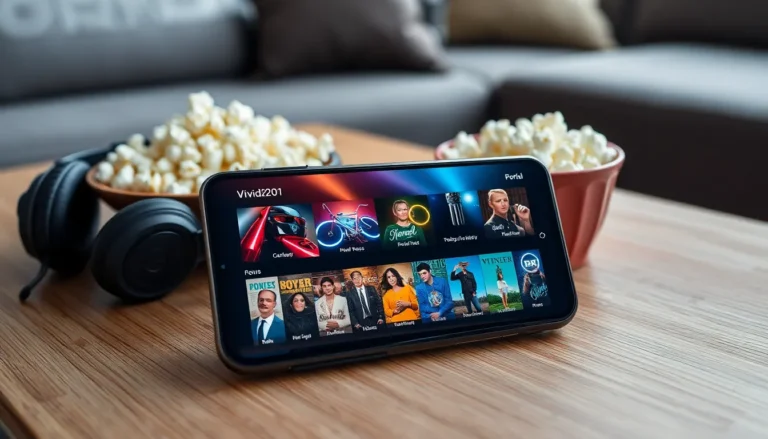Imagine a world where your fridge knows when you’re out of milk and your thermostat adjusts itself based on your mood—welcome to the Internet of Things (IoT). This revolutionary design concept is transforming everyday objects into smart devices that communicate seamlessly. It’s not just about convenience; it’s about creating a lifestyle that’s more efficient, connected, and yes, a little more fun.
As technology evolves, so does the way designers approach IoT. They’re not just crafting gadgets; they’re building ecosystems that enhance daily living. With a dash of creativity and a sprinkle of innovation, IoT design is paving the way for smarter homes and cities. Dive into the exciting world of IoT design and discover how it’s reshaping our interactions with the devices around us—one quirky gadget at a time.
Table of Contents
ToggleOverview of Internet of Things Design
Internet of Things design centers on creating interconnected devices that seamlessly work together. Designers emphasize user experience while integrating technology into daily life. Smart devices, including wearables, home automation systems, and industrial equipment, all play a role in this ecosystem. By prioritizing communication among devices, designers foster collaboration that enhances user interaction and efficiency.
A user-friendly interface is essential in IoT design. Users expect easy navigation and straightforward functionality. Customization features allow individuals to tailor devices to their preferences, ensuring satisfaction and engagement. Incorporating feedback from users during the design process further refines the overall experience.
Security considerations are critical for IoT design. Vulnerabilities in connected devices can lead to significant privacy risks. Designers implement encryption and secure access protocols to protect data transmission. Regular updates and strong authentication measures help mitigate potential threats.
Scalability remains a key consideration. As more devices join the IoT landscape, systems must adapt to accommodate growth. Modular design principles allow new components to integrate without requiring extensive overhauls. This flexibility ensures longevity and relevance in a rapidly evolving technological environment.
Interoperability is vital for maximizing the potential of IoT networks. Devices from various manufacturers must communicate effectively, enabling functionalities across different platforms. Adhering to established standards enhances compatibility, encouraging broader adoption of smart technologies.
Successful IoT design incorporates user-centered principles, robust security measures, scalability, and interoperability. By focusing on these elements, designers create innovative solutions that enrich lives and redefine how technology interacts with everyday environments.
Key Principles of Internet of Things Design

Designing for the Internet of Things involves several key principles that enhance user experience and functionality. Understanding these principles is essential for creating effective IoT solutions.
User-Centric Approach
Focusing on the user serves as the cornerstone of IoT design. Designers prioritize intuitive interfaces, ensuring that users interact effortlessly with devices. Incorporating feedback loops allows for continuous improvement based on user experiences. Features geared toward customization empower users to tailor devices to their preferences. Each step centers around reducing cognitive load, making smart technology accessible to a broader audience. Emphasizing usability transforms technology from complex tools into seamless extensions of daily life.
Scalability and Flexibility
Scalability stands as a crucial consideration in IoT design. Modular systems enable designers to introduce new components without disrupting existing functionalities. This flexibility allows for future innovations, ensuring devices evolve alongside user needs. Integration with various platforms enhances compatibility, fostering a more extensive network of interconnected devices. Addressing potential growth from the outset creates solutions equipped to handle increased data demands. Ready adaptability ensures longevity, making it easier to incorporate new technologies as they emerge.
Essential Components of Internet of Things Design
Key components create the foundation of effective Internet of Things (IoT) design. Understanding these elements ensures optimal functionality and user experience.
Sensors and Actuators
Sensors detect environmental changes, collecting data from surroundings. They measure variables like temperature, motion, and humidity. Actuators respond to this data by performing actions, such as turning on a light or adjusting a thermostat. Together, these elements transform inert objects into smart devices. For instance, smart thermostats utilize temperature sensors to optimize heating and cooling based on user patterns. Incorporating multiple sensor types enhances functionality, enabling devices to make informed decisions and communicate effectively.
Communication Protocols
Communication protocols govern how devices exchange data within IoT networks. Various protocols exist, including MQTT, CoAP, and HTTP, each suited for specific use cases. MQTT excels in low-bandwidth scenarios, while CoAP is designed for constrained devices, prioritizing efficiency. Effective communication protocols ensure seamless integration across different devices and platforms. They also facilitate interoperability, allowing devices from various manufacturers to operate cohesively. Selecting appropriate protocols significantly impacts the reliability and performance of IoT solutions, enhancing user experience and engagement.
Challenges in Internet of Things Design
Designing for the Internet of Things (IoT) presents several challenges that can impact device functionality and user experience. Effective solutions to these concerns enhance the overall ecosystem.
Security Concerns
Security poses significant challenges in IoT design. Vulnerabilities increase as more devices connect to the network, leading to potential breaches and privacy issues. Implementing robust security measures, like encryption and secure communication protocols, protects user data from unauthorized access. Regular updates and security patches maintain protection levels over time. Designers must integrate security considerations from the outset to build trust among users and safeguard sensitive information.
Interoperability Issues
Interoperability remains a crucial challenge in IoT design. Many devices from different manufacturers often struggle to communicate effectively. Creating standardized communication protocols enhances seamless integration within diverse networks. A focus on compatibility ensures devices function together, maximizing their utility. Designers must prioritize interoperability during development, allowing for greater flexibility in expanding IoT ecosystems and ensuring long-term system reliability.
Future Trends in Internet of Things Design
Advancements in artificial intelligence (AI) are set to redefine IoT design. AI integration allows devices to learn user behaviors, leading to more personalized experiences. Predictive analytics offer insights that improve device performance and energy efficiency.
Edge computing plays a crucial role in optimizing IoT networks. By processing data closer to the source, latency reduces and real-time decision-making enhances. This shift minimizes the need for continuous cloud communication, improving response times.
Sustainability is becoming a priority in IoT development. Designers focus on creating energy-efficient devices that consume less power and utilize renewable energy sources. Such practices not only reduce operational costs but also align with global sustainability goals.
Investments in smart cities continue to grow. Urban planners incorporate IoT solutions to improve public services and resource management. For example, intelligent traffic systems use IoT data to ease congestion and enhance safety.
Enhanced security measures are essential as the IoT landscape expands. Future designs will implement more sophisticated encryption protocols and multi-layered access controls. Regular software updates will also remain a top priority to address newly emerging vulnerabilities.
Interoperability challenges remain a focus, with efforts to establish universal communication standards. Creating seamless connections among devices from various manufacturers will enhance user experience and maximize utility. Collaborative initiatives among tech companies may lead to standardized frameworks that simplify integration.
User-centric designs will dominate future IoT solutions. Simplified interfaces and customizable features will make technology more accessible. Addressing user feedback during the design process will foster greater engagement and satisfaction.
The evolution of IoT design is reshaping how individuals interact with technology. By prioritizing user experience and incorporating robust security measures, designers are crafting solutions that not only enhance daily living but also address critical challenges. The focus on scalability and interoperability ensures that devices can adapt to changing needs without compromising functionality.
As advancements in AI and edge computing continue to emerge, the potential for personalized and efficient IoT experiences grows. With a commitment to sustainability and user-centric design, the future of IoT promises to deliver innovative solutions that enrich lives and foster deeper connections between people and technology. Embracing these trends will be essential for creating a smarter and more connected world.


